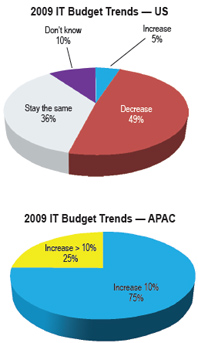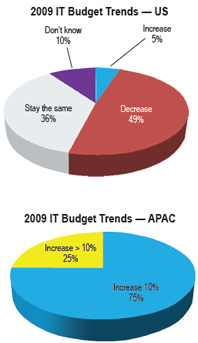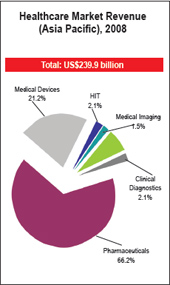A review on Healthcare Information Technology in Asian hospitals

Faced with escalating costs, challenged by falling efficiency, pressured by patients on affordability, quality, and equality, the healthcare industry once again is turning towards Healthcare Information Technologies (HIT) for help. As a result, at the end of the first decade of 21st century we are witnessing renewed interest in HIT that defies the economic downturn and failing global economy. Despite acute shortage of free flowing cash, lower revenues and profits, drop in patient visits, healthcare providers, in most cases, keep spending on healthcare IT products and services. In a survey that Frost & Sullivan has conducted early this year, majority of healthcare providers in the APAC region indicated that they are likely to keep their IT budgets intact if not having them increased. This is a big contrast when compared to other industries that, in response to ongoing recession, had to scale down their spending in order to preserve operations. On the global scale, Asia seems to be the world leader in HIT purchasing habits with most governments in the region pledging support for various types of electronic healthcare platforms. Also, the region recorded highest ratio of healthcare organizations willing to increase their IT budgets, with China having the biggest share. By comparison, at the beginning of 2008 the US spending on healthcare information technology was looking downward; however the USD 20 billion stimulus package for the implementation of Electronic Medical Record (EMR), released later that year, managed to reverse the trend with the current figures indicating an increase in spending by 10 percent on average. The HIT investment allocation varies by geography with APAC countries focusing more on software and applications rather than on hardware and network. The situation is on the opposite end in US where healthcare organizations tend to allocate more budgets for infrastructure. The variation can be explained by different priorities stemming up from the state of existing HIT infrastructure: degree of maturity, functional scope, and ability to expand and integrate. Asian countries, in general, are less advanced in adoption of healthcare applications and are seizing the opportunity to catch up. This, however, might not be true with Singapore, Hong Kong and, to a lesser degree, Taiwan as these countries are already in the process of implementing nationwide electronic health records. The healthcare industry in US has been the forerunner in utilization of IT and in most cases basic applications are already in place. Therefore, the purchasing attention is directed towards expanding and modernizing existing infrastructure by latest advances in wireless and mobile technologies.


According to Frost & Sullivan estimates, the HIT market (by revenue) in 2008, in APAC (Southeast Asia, China Japan Australia) was close to USD 5.04 billion with an annual growth rate (CAGR) of 11.8 percent from 2005 ?2008. Due to global economic downturn, the growth rate in the next 2 years could fall below 10 percent. Once the economy is on the rebound the growth rate is expected to rise and stabilize in the mid and upper teens. Although the APAC HIT market represents currently only 2.1 percent of the total healthcare market it is very likely that the figure could double if not triple in the course of the next 10 years. The main factor behind such strong growth tendency is the contribution of bioinformatics to the development of new diagnostic and therapeutic technologies. The healthcare industry is still lagging behind other industries in the adoption of information technologies. At present, the gap stands at about 5 to 10 years, depending on products and technologies, but it is shrinking fast as HIT adoption and g
Buty sportowe Nike Faced with escalating costs, challenged by falling efficiency, pressured by patients on affordability, quality, and equality, the healthcare industry once again is turning towards Healthcare Information Technologies (HIT) for help. As a result, at the end of the first decade of 21st century we are witnessing renewed interest in HIT that defies the economic downturn and failing global economy. Despite acute shortage of free flowing cash, lower revenues and profits, drop in patient visits, healthcare providers, in most cases, keep spending on healthcare IT products and services. In a survey that Frost & Sullivan has conducted early this year, majority of healthcare providers in the APAC region indicated that they are likely to keep their IT budgets intact if not having them increased. This is a big contrast when compared to other industries that, in response to ongoing recession, had to scale down their spending in order to preserve operations. On the global scale, Asia seems to be the world leader in HIT purchasing habits with most governments in the region pledging support for various types of electronic healthcare platforms. Also, the region recorded highest ratio of healthcare organizations willing to increase their IT budgets, with China having the biggest share. By comparison, at the beginning of 2008 the US spending on healthcare information technology was looking downward; however the USD 20 billion stimulus package for the implementation of Electronic Medical Record (EMR), released later that year, managed to reverse the trend with the current figures indicating an increase in spending by 10 percent on average. The HIT investment allocation varies by geography with APAC countries focusing more on software and applications rather than on hardware and network. The situation is on the opposite end in US where healthcare organizations tend to allocate more budgets for infrastructure. The variation can be explained by different priorities stemming up from the state of existing HIT infrastructure: degree of maturity, functional scope, and ability to expand and integrate. Asian countries, in general, are less advanced in adoption of healthcare applications and are seizing the opportunity to catch up. This, however, might not be true with Singapore, Hong Kong and, to a lesser degree, Taiwan as these countries are already in the process of implementing nationwide electronic health records. The healthcare industry in US has been the forerunner in utilization of IT and in most cases basic applications are already in place. Therefore, the purchasing attention is directed towards expanding and modernizing existing infrastructure by latest advances in wireless and mobile technologies.
Faced with escalating costs, challenged by falling efficiency, pressured by patients on affordability, quality, and equality, the healthcare industry once again is turning towards Healthcare Information Technologies (HIT) for help. As a result, at the end of the first decade of 21st century we are witnessing renewed interest in HIT that defies the economic downturn and failing global economy. Despite acute shortage of free flowing cash, lower revenues and profits, drop in patient visits, healthcare providers, in most cases, keep spending on healthcare IT products and services. In a survey that Frost & Sullivan has conducted early this year, majority of healthcare providers in the APAC region indicated that they are likely to keep their IT budgets intact if not having them increased. This is a big contrast when compared to other industries that, in response to ongoing recession, had to scale down their spending in order to preserve operations. On the global scale, Asia seems to be the world leader in HIT purchasing habits with most governments in the region pledging support for various types of electronic healthcare platforms. Also, the region recorded highest ratio of healthcare organizations willing to increase their IT budgets, with China having the biggest share. By comparison, at the beginning of 2008 the US spending on healthcare information technology was looking downward; however the USD 20 billion stimulus package for the implementation of Electronic Medical Record (EMR), released later that year, managed to reverse the trend with the current figures indicating an increase in spending by 10 percent on average. The HIT investment allocation varies by geography with APAC countries focusing more on software and applications rather than on hardware and network. The situation is on the opposite end in US where healthcare organizations tend to allocate more budgets for infrastructure. The variation can be explained by different priorities stemming up from the state of existing HIT infrastructure: degree of maturity, functional scope, and ability to expand and integrate. Asian countries, in general, are less advanced in adoption of healthcare applications and are seizing the opportunity to catch up. This, however, might not be true with Singapore, Hong Kong and, to a lesser degree, Taiwan as these countries are already in the process of implementing nationwide electronic health records. The healthcare industry in US has been the forerunner in utilization of IT and in most cases basic applications are already in place. Therefore, the purchasing attention is directed towards expanding and modernizing existing infrastructure by latest advances in wireless and mobile technologies. 
 According to Frost & Sullivan estimates, the HIT market (by revenue) in 2008, in APAC (Southeast Asia, China Japan Australia) was close to USD 5.04 billion with an annual growth rate (CAGR) of 11.8 percent from 2005 ?2008. Due to global economic downturn, the growth rate in the next 2 years could fall below 10 percent. Once the economy is on the rebound the growth rate is expected to rise and stabilize in the mid and upper teens. Although the APAC HIT market represents currently only 2.1 percent of the total healthcare market it is very likely that the figure could double if not triple in the course of the next 10 years. The main factor behind such strong growth tendency is the contribution of bioinformatics to the development of new diagnostic and therapeutic technologies. The healthcare industry is still lagging behind other industries in the adoption of information technologies. At present, the gap stands at about 5 to 10 years, depending on products and technologies, but it is shrinking fast as HIT adoption and gButy sportowe Nike
According to Frost & Sullivan estimates, the HIT market (by revenue) in 2008, in APAC (Southeast Asia, China Japan Australia) was close to USD 5.04 billion with an annual growth rate (CAGR) of 11.8 percent from 2005 ?2008. Due to global economic downturn, the growth rate in the next 2 years could fall below 10 percent. Once the economy is on the rebound the growth rate is expected to rise and stabilize in the mid and upper teens. Although the APAC HIT market represents currently only 2.1 percent of the total healthcare market it is very likely that the figure could double if not triple in the course of the next 10 years. The main factor behind such strong growth tendency is the contribution of bioinformatics to the development of new diagnostic and therapeutic technologies. The healthcare industry is still lagging behind other industries in the adoption of information technologies. At present, the gap stands at about 5 to 10 years, depending on products and technologies, but it is shrinking fast as HIT adoption and gButy sportowe Nike
 iConnectHub
iConnectHub
 Login/Register
Login/Register Supplier Login
Supplier Login


























